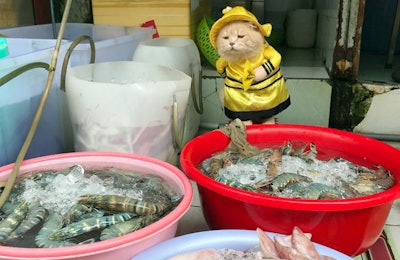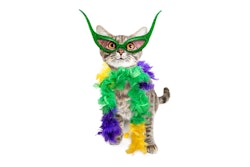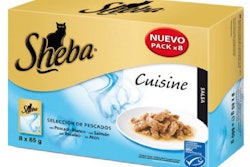
In Hai Phong, Vietnam, lives a fishmonger's cat named Chó (which means “dog” in English).
A 4-year-old Scottish Fold, who wears a traditional bright yellow silk garment when pretending to sell seafood at a public market, Chó, or Dog as he is more fondly called by his 150,000 Instagram followers, broke into social media stardom in 2018. It was a fulfillment of his millennial owner's wish to make Chó popular so he could indirectly promote Vietnam, a country that is lately becoming more pet friendly.
Changing perceptions of dogs and cats in Vietnam
A word of caution: Do not search on Google for “dog or cat food in Vietnam” unless you are prepared to see graphic images of these animals prepared for human consumption, as Vietnam still has a large population that eats cats and dogs — a fact that runs somewhat counter to the growth of its pet food industry.
However, Chó's rise to internet celebrity status indicates things are changing in Vietnam's pet scene as young people with buying power make more pro-pet choices.
Vietnam's 2019 population is expected to reach 97.43 million, of which 65% are under 35 years old — an age group noted to likely have pets following Western standards. This makes Vietnam a nascent market for pet food and even a potential manufacturing hub for it.
Pet humanization is a trend happening in major cities like Ho Chi Minh City (Saigon) and Hanoi, and in secondary urban centers of Hai Phong, Can Tho and Da Nang. In these places are large concentrations of middle-class families where the matriarchs, usually in their 30s or older with full control of family budgets, are responsible for all purchases that include pet food and pet services. Also in these cities are thousands of expats willing to spend on premium pet food and pet care items.

J & PetShop & Spa has four locations in Hanoi and one in Saigon. Small family-owned pet shops with three to five employees are common in Vietnam. | Courtesy J & PetShop & Spa
Meanwhile, in the capital city of Hanoi, officials recently urged residents to stop eating dogs and cats due to sanitation and image concerns. As of September 2018, Hanoi is home to nearly half a million dogs and cats, most kept as pets.
Pet food market highlights
Vietnam used to be one of the poorest nations in the world. Rising from the ashes of a 20-year war that ended in 1975, Vietnam became an economic miracle and transformed itself into a middle-income country. With steady income at their disposal, locals became more open to owning pets like Chó.
Statista, an online portal for market surveys and reports, values Vietnam's pet food segment at US$42 million in 2019 with a compound annual growth rate of 7.3% (CAGR 2019–23). This covers food for dogs and cats, as well as feeds for other house pets such as rodents and reptiles. In addition, Statista offers per-person revenues of US$0.4 in 2019 while the average per-capita consumption stands at 0.3 kg.
Compared to countries with mature pet markets, these numbers are quite small but consistent with historical data from local research company Q&ME. In October 2014, they surveyed 200 Vietnamese nationals age 18 years old and above who have had pet dogs for years. At that time, a household's average monthly budget for dog food was also relatively small: only up to 300,000 Vietnamese Dong (VND), which today roughly translates to US$13.00.
Despite the locals' fondness for Western purebred dogs and cats, many continue to feed their animal companions table scraps. Clearly, there's an urgent need to educate the market on proper pet nutrition and basic pet healthcare, but the limited range of commercial pet food in Vietnam isn't helping.
Mars Petcare, Royal Canin and few other foreign pet food labels have already settled in this tiny nation, but Vietnam can use more international players to come in fast and offer varieties, preferably premium.
The foreign business club British Business Group Vietnam believes access to more premium pet products will elevate pet owners' standards and veer them away from buying only low-cost processed pet food. Until then, consumers will be loyal to cheap dog and cat food brands, which currently account for 70% of the market.
Made in Vietnam
Aside from feeding Vietnam's cats and dogs, pet food companies can also move their manufacturing activities here.
Companies looking to relocate their production sites in China to Vietnam are encouraged by the country's compelling “report card” from world economic experts. Based on the World Economic Forum's Global Competitiveness Report, Vietnam climbed to 55th place in 2017 from 77th in 2006. The World Bank also saw the “rising dragon” shoot to 68th place from 104th place between 2007 and 2017 from the global Ease of Doing Business rankings. In 2018, Vietnam impressed the Bank by making “progress on everything from enforcing contracts, increasing access to credit and electricity, paying taxes and trading across borders.”
Now that China is embroiled in a punishing trade war with the U.S., Vietnam, whose 6–7% economic growth rivals China, can become the new preferred choice for low-cost manufacturing of pet products, particularly from companies open to a “China Plus One” strategy.
Vietnam B2B Direct, an international trade solutions company, said Vietnam's labor cost is less than Thailand and China, where many pet food manufacturers operate. It is also strategically located to service neighboring Asian countries.
At present, very few are creating products for small companion animals in Vietnam. Local company HappyChews Pet Foods Company was founded in 2013 and thus enjoys an early mover advantage. It quickly became a prominent manufacturer and supplier of dry pet foods like rawhides for the domestic market and export markets (U.S. and Japan). Its current capacity is 6,000 metric tons/year, compliant to international standards under the U.S. Food and Drug Administration (FDA), HACCP (Hazard Analysis and Critical Control Point) and British Retail Consortium (BRC).
Others enter the Vietnam pet food sector by partnering with local OEM solutions providers like Total Petfood Vietnam Co. which offers everything from manufacturing to warehousing services. Another option is to enter into distribution agreements with private firms like what Avivagen Inc. did late in 2018 by partnering with Viphavet Co. Ltd. to market its Vivamune Health Chews to local pet owners.
Vietnam's pet food sector is open for business. The relaxed regulatory measures in place are like welcome mats so industry players will be encouraged to come in. Research firm Mordor Intelligence said the industry's success will be largely dependent, too, on the promotional strength and consumer interaction capabilities of the manufacturers. One thing, however, that already proved effective is to have furry social media influencers like Chó to raise awareness about good pet ownership. With his star power, Chó created ripples in the market by making companion pets look good and desirable, breathing life to a pet industry that used to be non-existent or largely unheard of a couple of years ago.
















